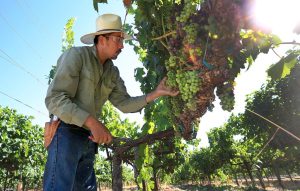1.4 | The Five Factors of Production in Agriculture
Land, Labor, Capital, Entrepreneurship, and Knowledge in Agriculture
Anthony Farao
Welcome to one of the foundational building blocks of agricultural economics and business planning: the factors of production. These five essential resources—Land, Labor, Capital, Entrepreneurship, and Knowledge—enable all agricultural operations, from family farms to global food processors, to produce goods and services.

The Five Core Factors
| Factor | Quick Definition | Example |
|---|---|---|
| Land | Natural resources like soil, water, and climate | Almond orchards in the Central Valley |
| Labor | Human effort (physical or intellectual) | Vineyard workers during harvest |
| Capital | Tools, machines, and buildings used in production | Milking machines in a dairy |
| Entrepreneurship | The vision and risk-taking behind starting a business | Launching a beef subscription box business |
| Knowledge | Regulatory, technical, and industry-specific know-how | Using GIS to optimize irrigation in lettuce |
Each of these factors contributes something essential. You can think of Land and Labor as the groundwork, Capital as the machinery, Entrepreneurship as the drive, and Knowledge as the GPS that keeps you on the right path.
Quick Definitions:
- Land: The physical space and resources needed to grow and raise agricultural products.
- Labor: The skilled and unskilled human work needed to operate every aspect of an ag enterprise.
- Capital: The machinery, equipment, and infrastructure that make production more efficient.
- Entrepreneurship: The leadership and risk-taking spirit that drives innovation.
- Knowledge: The understanding of regulations, science, and market trends that inform smart decisions.
📌 Try This: What are three of these factors you would need to start a hydroponic basil farm?
Examples
Why Knowledge Stands Out
Knowledge integrates all the other factors. A farmer may have good land and equipment, but without knowledge—such as how to comply with water laws, read soil test results, or use drone data—they risk falling behind.
Today’s ag professionals must be:
- Tech-savvy: Using AI, GPS, sensors
- Legally aware: Navigating ag laws and labor rules
- Consumer focused: Responding to demand for sustainability, organic, and traceability
💬 Reflection Prompt: Which of these five factors do you think is hardest to access for beginning farmers? Why?
Exercises
Matching Activity:
Match each career or operation below with the factor(s) it relies on most:
- Irrigation Technician → ________ + ________
- Startup Farm Owner → ________ + ________ + ________
- Food Safety Inspector → ________ + ________
🎯 Hint: You might pick Knowledge + Capital or Entrepreneurship + Labor depending on the example.
Tied to Your Learning:
- CSLO 1: Explain how economic principles relate to agricultural business management.
- Course Objective 1: Understand production inputs and their economic value.
- Course Objective 4: Recognize the regulatory and policy influences on ag resources.
This content directly supports your ability to create a thoughtful and realistic business plan in this course.
📸 Image Suggestions to Enhance Learning:
- Land: Soil test kit in a field, satellite image of farmland
- Labor: Grape harvest crew, livestock technician
- Capital: Tractor using GPS, drip irrigation setup
- Entrepreneurship: Young farm owner pitching idea
- Knowledge: Tablet showing irrigation heat map or ag compliance guide
These visuals will appear throughout your course materials and the textbook. Look for them as cues to reinforce key concepts.
